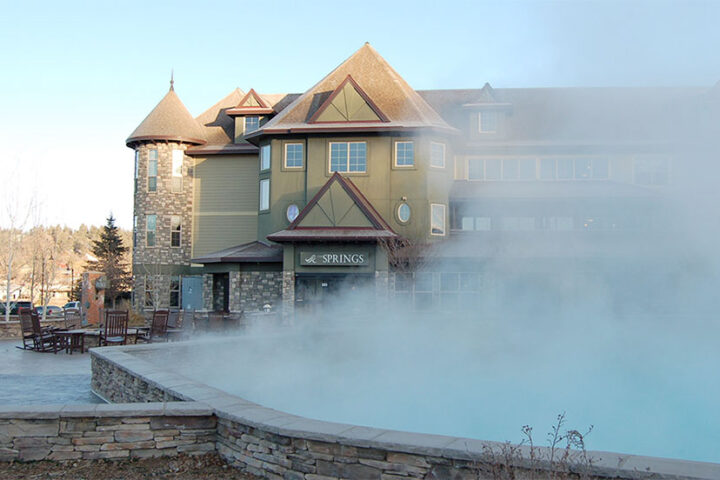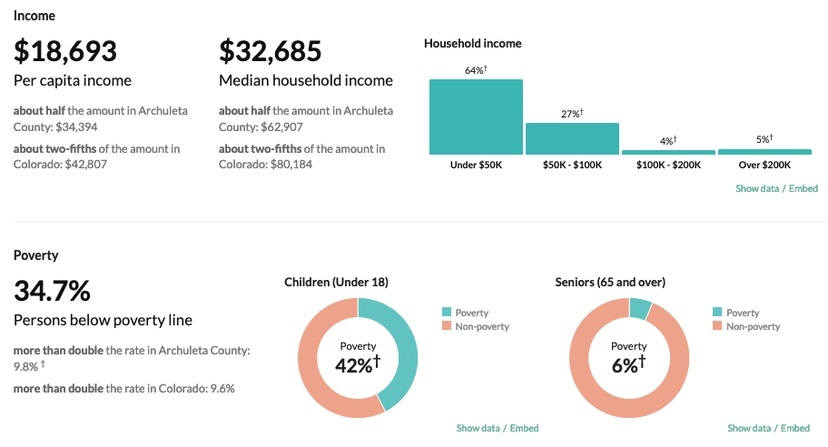PHOTO: The trusty heat exchanger that serves the Town of Pagosa Springs’ downtown geothermal heating system.
The Town of Pagosa Springs has owned and operated a geothermal heating system since December 1982 to provide geothermal heating during the colder months to customers in Town. The Town’s geothermal heating system was funded by the Department of Energy (DOE) with additional funds provided by Archuleta County and the Town. The total cost to complete the system was over $1.4 million (roughly $3.96 million in 2020 dollars). Currently, the system has 32 customers of varying sizes and is fully operational (shutdown for summer). The heating season for our geothermal system is typically October through April…
— from the July 7, 2020 Town Council agenda packet.
During a recent Council meeting at Pagosa Springs Town Hall, I heard two of our seven Council members ask about reconsidering the way we use our geothermal resources… — specifically, the aquifer of hot, mineral-rich water that underlies downtown Pagosa Springs — and asking the question: Should the Town of Pagosa Springs be working to expand our geothermal-powered municipal heating system?
A system that currently serves only 35 residential homes?
At a time when our nation, and the world as a whole, is talking about a carbon-free energy future…
…and at a time when our existing carbon-based energy infrastructure in Pagosa Springs is seeing constant price increases…
…and at a time when more than 40% of the children within the town limits live below the federal poverty line…
… does the Town government really want to divert up to 450 GPM of publicly-owned hot water — up to 237 million gallons per year — to a privately-owned resort, when that same amount of heat energy could conceivably be delivered to families residing in the neighborhoods surrounding the Great Pagosa Hot Spring….?

As mentioned previously, the Town was, in 1988, granted a water right for 450 GPM from their new PS-5 and PS-3 wells, located in Centennial Park behind the old County Courthouse. The water diversion was intended to serve an innovative heating system for downtown buildings — businesses, schools, and homes — at a cost lower than gas or electric heat.
I’ve enjoyed following the crazy political maneuvering that has bubbled up over the past 30 years, around the existence of geothermal water in Pagosa Springs.
We had, for example, a local business group extract $500,000 in taxpayer revenue from the Town and County governments, to drill several exploratory wells south of downtown, with the idea that Pagosa Springs could use new sources of hot, geothermal water to generate electricity, and maybe raise tilapia fish as well. That project was also supported by the U.S. Department of Energy and the State of Colorado, to the tune of, potentially, $3.8 million, but after a couple of wells were drilled and no new hot water was found, the DOE pulled its funding for the project.
In 2009, the non-profit Geothermal Greenhouse Partnership (GGP) acquired the western end of Centennial Park to construct three ‘Growing Spaces’ greenhouse domes to provide food for the community, and education and tours in the ‘Education Dome’. A third dome is aimed at an experimental aquaculture-horticulture mix. The project has benefited from well over $1 million in taxpayer subsidies.

In order to help facilitate grant funding for the project, the Town government promised to supply geothermal water to the domes for winter heating, out of the Town’s total water right of 450 GPM. As I understand it, the locally-produced ‘Growing Spaces’ greenhouse domes are specially designed to function through a Pagosa winter on a passive solar basis — without the need for additional heating. But the Town nevertheless granted GGP up to 100 GPM of hot water (free of charge? …while charging the rest of our downtown businesses, schools, and homes on the geothermal heating system a monthly fee for heating…?)
The Education Dome is reportedly “open for tours and vegetable sales” from 10am-1pm every Monday, Wednesday and Saturday.
Also in 2009, the Town Council determined that The Springs Resort could benefit from up to 450 GPM of hot water, at a cost of $.10 per ‘therm’ — allowing that up to 100 GPM might be diverted to the GGP as needed. The other businesses, schools and homes have been charged six times that rate: $.60 per therm.
The Town has had the right to track the Resorts water diversions, to ensure that the proper fees were being collected… but apparently, has never done so.
As noted previously, the Town has the right to adjust the fees charged to the Resort this coming January.
But should the Town be subsidizing a private tourist resort (if indeed $.10 per therm amounts to a subsidy) when 35% of the downtown population lives below the federal poverty line, and when electricity and gas prices are continuing to climb?

The system currently serves only about 35 out of about 800 downtown buildings. Could the Town conceivably serve the entire downtown with low-cost winter heating?
Apparently not… without completely redesigning the system.
According to a 2020 report from Durango-based engineering consultants Plummer, the least efficient use of geothermal heat involves heating sidewalks and driveways — something that the Town allows throughout downtown. But beyond the ways we might be wasting our resource, the geothermal heating system has a limited capacity.
From that report:
The remaining capacity of the existing system is estimated to be the difference between current amount of heat transfer, 131,100 kBtu/day and the maximum rate of 158,900 kBtu/day; the resulting available capacity is estimated to be 27,800 kBtu/day. Based on previous meter readings, the average customer uses 3,150 kBtu/day; if the data excludes the largest consumers and focuses on residential customers, the average reduces to 2,100 kBtu/day. There is potential to add up to 9 new average customers or 13 average residential customers.
If the distribution piping were replaced with insulated materials, the system loss could be significantly reduced while increasing availability of sellable energy. Section 2.4.3 shows a potential heat savings of up to 19,800 kBtu/day. This could allow an additional 6 to 10 customers to be added to the system.
Just to keep the current system operating as it is, Plummer projected the need for about $4 million in upgrades and maintenance. A review of the Town’s new Five-Year Capital Improvement Plan — which might be approved at the Town Council meeting tomorrow evening — suggests that the Town is not planning any such investment, over at least the next five years.
A common term for that approach is “deferred maintenance.” It’s a popular government strategy in America.
We also might consider…35 customers… $4 million in needed maintenance. That’s $114,000 per customer. Do the 35 customers want to pay for those upgrades?
Or maybe The Springs Resort can afford to foot the bill?
